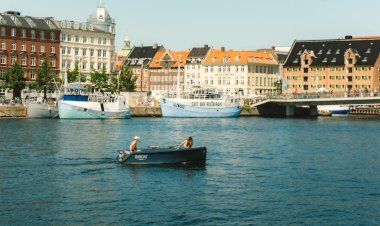The Longest Beach in the World – Where Endless Sand Meets the Sea
Discover the Longest Beach in the World at Cox’s Bazar, Bangladesh. Explore its history, beauty, culture, and travel tips for your 2025 adventure.

Few natural wonders leave travelers in awe quite like a seemingly endless coastline. The sound of crashing waves, golden sands stretching beyond the horizon, and the mesmerizing union of ocean and sky create an unforgettable experience. Among all the world’s coastal treasures, Cox’s Bazar in Bangladesh proudly holds the title of the Longest Beach in the World. Spanning an impressive 120 kilometers (75 miles), this breathtaking destination is more than just a beach—it is a cultural landmark, a thriving hub of biodiversity, and a must-visit for explorers who crave both beauty and adventure.
In this guide, we’ll explore everything about the Longest Beach in the World: its history, geography, attractions, culture, and practical tips to make your visit seamless.
What Is the Longest Beach in the World?

When people ask about the “longest beach,” they often refer to natural sandy stretches uninterrupted by rocky terrain or urban development. By this definition, Cox’s Bazar holds the crown as the Longest Beach in the World. Situated in southeastern Bangladesh along the Bay of Bengal, it boasts:
-
120 km of unbroken sandy coastline
-
Wide shores with gentle slopes
-
Scenic views flanked by hills and lush greenery
While there are technically longer beaches like Praia do Cassino in Brazil (over 200 km), it is not classified as the Longest Natural Sandy Beach in the World in the same way Cox’s Bazar is recognized.
History & Significance
The roots of Cox’s Bazar stretch deep into colonial history. The town was named after Captain Hiram Cox, an officer of the British East India Company in the late 18th century. He established the settlement while rehabilitating refugees in the region, and his name became immortalized through the coastal town.
Beyond history, Cox’s Bazar has emerged as the “Tourism Capital of Bangladesh”. Its reputation as the Longest Beach in the World makes it a magnet for both local and international travelers. It is central to the country’s economic growth, providing thousands of jobs in hospitality, tourism, and fishing.
Geography and Natural Features
Cox’s Bazar sits along the southeastern edge of Bangladesh, where the lush Chittagong Hill Tracts meet the Bay of Bengal. Its geography is as fascinating as its length:
-
Golden sands: Soft and wide, ideal for walking barefoot.
-
Gentle waves: Perfect for swimming and surfing.
-
Scenic hills: The Himchari hills provide a picturesque backdrop.
-
Biodiversity: The beach borders mangroves, forests, and unique marine habitats.
The appeal of the Longest Beach in the World also lies in its natural beauty—sunrise and sunset here are especially enchanting, painting the skies in vivid hues of orange, pink, and purple.
Cox’s Bazar vs Other Famous Long Beaches
| Beach Name | Country | Length (Approx.) | Special Feature |
|---|---|---|---|
| Cox’s Bazar | Bangladesh | 120 km | Longest natural sandy beach |
| Praia do Cassino | Brazil | 212 km | Longest continuous beach overall |
| Ninety Mile Beach | Australia | 151 km | Golden dunes & surf |
| Padre Island Beach | USA | 182 km | Longest barrier island beach |
While Praia do Cassino in Brazil technically covers a greater length, Cox’s Bazar remains unique as the longest uninterrupted and naturally sandy beach in the world.
Wildlife & Marine Life
The Bay of Bengal nurtures a diverse ecosystem:
-
Sea turtles: Green and Olive Ridley turtles are often spotted nesting.
-
Birds: Migratory birds, including plovers and sandpipers, flock here.
-
Marine life: Colorful fish, crabs, and even rare species like whale sharks inhabit these waters.
Conservation efforts are growing, but the region faces significant challenges, including coastal erosion, climate change, and increased tourism pressure.
Things to Do at the Longest Beach

-
Beach Activities
-
Sunbathing, beach volleyball, and sand art.
-
Surfing and jet skiing for thrill-seekers.
-
Relaxing beach walks on endless sand.
-
-
Photography
-
Golden sunsets.
-
Fishermen with their nets at dawn.
-
The vast horizon where sky meets sea.
-
-
Local Food
-
Fresh seafood: crabs, lobsters, prawns, and hilsa fish.
-
Street-side snacks like fried fish balls and coconut drinks.
-
-
Nearby Attractions
-
Himchari National Park: Known for waterfalls and wildlife.
-
Inani Beach: Famous for its coral stones.
-
St. Martin’s Island: A coral island paradise.
-
Best Time to Visit

Bangladesh has a tropical climate, so timing is key:
-
November to March (Dry Season): Best months for clear skies, comfortable temperatures, and calm seas.
-
April to June (Summer): Hotter, but fewer crowds.
-
July to October (Monsoon): Heavy rainfall and storms—best avoided unless you love dramatic skies.
If you want to see the Longest Beach in the World in its most beautiful form, plan your trip during the dry season.
Travel Guide: How to Reach Cox’s Bazar
-
By Air: Cox’s Bazar Airport connects with Dhaka and Chittagong. International flights are expanding.
-
By Road: Luxury buses run daily from Dhaka and Chittagong.
-
By Train: Plans are underway to connect via railway.
Accommodation Options:
-
Budget stays: Guesthouses near the main beach road.
-
Mid-range hotels: Comfortable stays with sea views.
-
Luxury resorts: 5-star hotels offering infinity pools and fine dining.
Local Culture & Experiences
Cox’s Bazar isn’t just about sand and sea—it’s also a cultural journey.
-
Local communities: Warm and hospitable, offering insights into coastal life.
-
Handicrafts: Bamboo and cane items, seashell jewelry, and traditional textiles.
-
Festivals: Colorful beach carnivals and cultural fairs enhance the experience.
Experiencing the Longest Beach in the World also means immersing yourself in Bangladeshi culture.
Practical Travel Tips

-
Carry sunscreen, hats, and comfortable sandals.
-
Respect local culture: modest swimwear is recommended.
-
Bargain at markets but do so politely.
-
Currency: Bangladeshi Taka (BDT).
-
English is understood in tourist zones, but learning a few Bangla phrases helps.
Interesting Facts About Cox’s Bazar
-
Known as the “Tourism Capital of Bangladesh.”
-
Once a small fishing village, now a global attraction.
-
Hosting one of the largest refugee camps in the world nearby (Rohingya camps).
-
Cox’s Bazar is being developed as a “Blue Economy Zone” for marine resources.
FAQs
Q1: Which is the Longest Beach in the World?
A: Cox’s Bazar in Bangladesh, with about 120 km of uninterrupted sandy coastline.
Q2: How long is Cox’s Bazar beach?
A: Approximately 120 kilometers (75 miles).
Q3: Is Cox’s Bazar safe for tourists?
A: Yes, it’s generally safe, though travelers should follow standard safety practices.
Q4: What activities can tourists enjoy there?
A: Swimming, surfing, beach sports, sightseeing, and trying local seafood.
Q5: When is the best season to visit the Longest Beach in the World?
A: November to March for ideal weather.
Conclusion
The Longest Beach in the World—Cox’s Bazar—is more than a natural marvel. It’s a place where endless sand meets the sea, offering travelers a blend of beauty, culture, and adventure. Whether you’re wandering barefoot along its vast stretch, savoring fresh seafood, or watching a golden sunset, the experience is unforgettable.
If you’re planning your next great escape, Cox’s Bazar deserves a spot at the top of your travel bucket list. After all, there’s nothing quite like standing on the Longest Beach in the World, feeling the ocean breeze, and realizing that the horizon truly has no end.
Read More: Relax, Recharge, Explore: Short Breaks in Scotland for Every Traveler

 alissaperry
alissaperry 






















